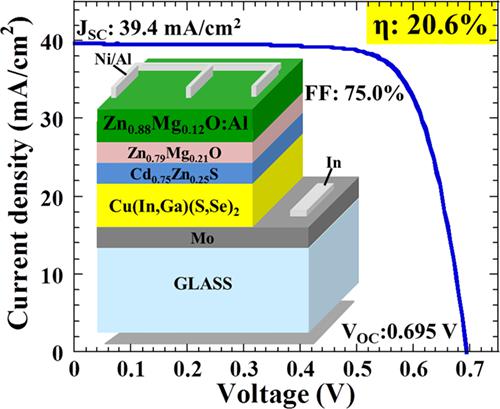当前位置:
X-MOL 学术
›
Prog. Photovoltaics
›
论文详情
Our official English website, www.x-mol.net, welcomes your feedback! (Note: you will need to create a separate account there.)
Aluminum‐doped Zn1 − xMgxO as transparent conductive oxide of Cu(In,Ga)(S,Se)2‐based solar cell for minimizing surface carrier recombination
Progress in Photovoltaics ( IF 6.7 ) Pub Date : 2017-06-21 , DOI: 10.1002/pip.2911 Jakapan Chantana 1 , Takuya Kato 2 , Hiroki Sugimoto 2 , Takashi Minemoto 1
Progress in Photovoltaics ( IF 6.7 ) Pub Date : 2017-06-21 , DOI: 10.1002/pip.2911 Jakapan Chantana 1 , Takuya Kato 2 , Hiroki Sugimoto 2 , Takashi Minemoto 1
Affiliation

|
A 19.5%‐efficient Cu(In,Ga)(S,Se)2 (CIGSSe)‐based solar cell is obtained by replacing traditional CdS/ZnO buffer layers with Cd0.75Zn0.25S/Zn0.79Mg0.21O buffer layers for increasing short‐circuit current density because band‐gap energies of Cd0.75Zn0.25S and Zn0.79Mg0.21O are wider than those of CdS and ZnO, respectively. This yields the increase in external quantum efficiency in a short wavelength range of approximately 320 to 550 nm. Moreover, difference of conduction band minimum (EC) between Zn1 − xMgxO:Al (transparent conductive oxide, TCO) layer and CIGSSe absorber is optimized by varying [Mg]/([Mg] + [Zn]), x. It is revealed that Zn1 − xMgxO:Al films with [Mg]/([Mg] + [Zn]) in a range of 0.10 to 0.12, enhancing Eg from 3.72 to 3.76 eV, are appropriate as TCO because of their enhanced mobility and decreased carrier density. Addition of 12% Mg into ZnO:Al to form Zn0.88Mg0.12O:Al as TCO layer effectively decreases surface carrier recombination and improves photovoltaic parameters, especially open‐circuit voltage and fill factor. This is the first experimental proof of the concept for optimizing EC difference between TCO and absorber to minimize surface carrier recombination. Ultimately, conversion efficiency (η) of CIGSSe solar cell with alternative Cd0.75Zn0.25S/Zn0.79Mg0.21O/Zn0.88Mg0.12O:Al (TCO) layers is enhanced to 20.6%, owing to control of total EC alignment, which is higher η up to 12.6% relative as compared with the solar cell with traditional CdS/ZnO/ZnO:Al layers.
中文翻译:

铝掺杂的Zn1-xMgxO作为基于Cu(In,Ga)(S,Se)2的太阳能电池的透明导电氧化物,可最大程度地减少表面载流子复合
通过用Cd 0.75 Zn 0.25 S / Zn 0.79 Mg 0.21 O缓冲层替代传统的CdS / ZnO缓冲层以增加效率,可得到效率为19.5%的Cu(In,Ga)(S,Se)2(CIGSSe)基太阳能电池Cd 0.75 Zn 0.25 S和Zn 0.79 Mg 0.21 O的带隙能分别比CdS和ZnO的带隙能宽。这样在大约320至550 nm的短波长范围内提高了外部量子效率。此外,Zn 1 − x Mg x之间的导带最小值(E C)之差通过改变[Mg] /([[Mg] + [Zn]),x优化O:Al(透明导电氧化物,TCO)层和CIGSSe吸收剂。结果表明,ZnO 1- x Mg x O:Al膜的[Mg] /([[Mg] + [Zn])在0.10至0.12的范围内,使E g从3.72至3.76 eV增强,适合作为TCO,因为增强了迁移率并降低了载流子密度。在TCO层中向ZnO:Al中添加12%Mg以形成Zn 0.88 Mg 0.12 O:Al可有效减少表面载流子复合并改善光伏参数,特别是开路电压和填充系数。这是优化E C概念的第一个实验证明。TCO和吸收剂之间的差异,以最大程度地减少表面载体的重组。最终,由于控制了总的E C对准,具有替代Cd 0.75 Zn 0.25 S / Zn 0.79 Mg 0.21 O / Zn 0.88 Mg 0.12 O:Al(TCO)层的CIGSSe太阳能电池的转换效率(η)提高到20.6%。与具有传统CdS / ZnO / ZnO:Al层的太阳能电池相比,它的η高达12.6%。
更新日期:2017-06-21
中文翻译:

铝掺杂的Zn1-xMgxO作为基于Cu(In,Ga)(S,Se)2的太阳能电池的透明导电氧化物,可最大程度地减少表面载流子复合
通过用Cd 0.75 Zn 0.25 S / Zn 0.79 Mg 0.21 O缓冲层替代传统的CdS / ZnO缓冲层以增加效率,可得到效率为19.5%的Cu(In,Ga)(S,Se)2(CIGSSe)基太阳能电池Cd 0.75 Zn 0.25 S和Zn 0.79 Mg 0.21 O的带隙能分别比CdS和ZnO的带隙能宽。这样在大约320至550 nm的短波长范围内提高了外部量子效率。此外,Zn 1 − x Mg x之间的导带最小值(E C)之差通过改变[Mg] /([[Mg] + [Zn]),x优化O:Al(透明导电氧化物,TCO)层和CIGSSe吸收剂。结果表明,ZnO 1- x Mg x O:Al膜的[Mg] /([[Mg] + [Zn])在0.10至0.12的范围内,使E g从3.72至3.76 eV增强,适合作为TCO,因为增强了迁移率并降低了载流子密度。在TCO层中向ZnO:Al中添加12%Mg以形成Zn 0.88 Mg 0.12 O:Al可有效减少表面载流子复合并改善光伏参数,特别是开路电压和填充系数。这是优化E C概念的第一个实验证明。TCO和吸收剂之间的差异,以最大程度地减少表面载体的重组。最终,由于控制了总的E C对准,具有替代Cd 0.75 Zn 0.25 S / Zn 0.79 Mg 0.21 O / Zn 0.88 Mg 0.12 O:Al(TCO)层的CIGSSe太阳能电池的转换效率(η)提高到20.6%。与具有传统CdS / ZnO / ZnO:Al层的太阳能电池相比,它的η高达12.6%。

























 京公网安备 11010802027423号
京公网安备 11010802027423号